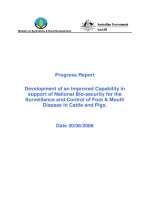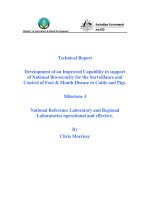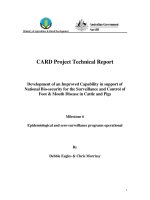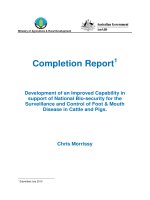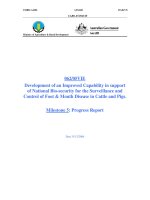Development of an intelligent electrolytic in process dressing (ELID) grinding system 6
Bạn đang xem bản rút gọn của tài liệu. Xem và tải ngay bản đầy đủ của tài liệu tại đây (16.19 KB, 4 trang )
Conclusions
115
Chapter 6
Conclusions
6.1 Main contributions of the research
ELID grinding is under research interest for last two decades and has evolved
considerably since. This current research work in ELID grinding mainly composed of
three major parts; development of a sensor integrated ELID grinding machine for both
flat and curvilinear surface machining; optimizing the dressing power by monitoring the
grinding condition; development of in-process truing system for the grinding wheel by
applying controlled dressing. The main contributions of this study are reviewed as
follows:
1. A sensor integrated intelligent machine tool has been developed and its
performance has been evaluated. Two types of sensors, namely inductive
sensor and laser sensor, were implemented to measure the metal bond profile
and the wheel outer profile respectively. The machine is capable of grinding
both flat and spherical surfaces. Surfaces with good optical properties
(average surface roughness Ra < 20nm) were successfully achieved with this
machine.
2. A new and essential methodology has been developed to compensate the tool
wear in ELID grinding during spherical surface machining. Tool wear is one
Conclusions
116
of the major concerns in ELID grinding because of its mechanism of wheel
dressing which produces form error on the machined surface. That is why this
proposed tool wear compensation method plays a vital role on the form
accuracy of the machined surface. The system uses a touch probe and CMM
(Co-ordinate measurement method) algorithm to measure machined surface
radius, if the radius of the curved surface is deviated from the desired value
then new cutting path is generated by considering the wheel wear. The process
continues until the desired radius is achieved. The profile accuracy has been
found to improve significantly when the tool wear compensation is used
during grinding.
3. A new concept of controlled voltage dressing by monitoring the grinding
condition has been implemented and its performance has also been evaluated.
Conventional ELID grinding applies constant voltage across the dressing zone
without monitoring the grinding wheel condition. This may lead to
overdressing of the wheel which eventually will shorten the tool life. In this
study grinding wheel condition has been assessed by continuously monitoring
the grinding force ratio and the dressing voltage has been adjusted accordingly.
The comparison result between the new concept and conventional grinding is
found to be very much optimistic. The new methodology reduces the tool
wear notably (almost 50%) in comparison to the conventional ELID dressing
method. However similar surface characteristic (average surface roughness,
peak to valley surface roughness) have been observed in both cases. Dressing
Conclusions
117
current has also been found to be more stable and uniform in this new form of
ELID grinding.
4. Truing of the grinding wheel is crucial in precision manufacturing, because
non-uniform wheel may lead to unstable grinding and bad form accuracy on
the machined surface. In ELID grinding the wheel is trued by applying
electrical discharges (EDM method). This method has two bad effects; it
creates thermal damages on the wheel surface and an extra attachment is
required to carry out the EDM truing. In order to address these problems
author has introduced a novel concept of wheel truing method in ELID
grinding, where the pulse width of the ELID power supply is controlled in-
process by continuously monitoring the wheel profile. An inductive sensor has
been used to measure the wheel profile. Proper signal conditioning has been
carried out by considering the convolution effect between the wheel and
electrode. A digital trunig controller has been designed, developed and
assessed. The wheel profile has been found to improve appreciably as the
controlled dressing is applied, moreover substantial improvement in wheel-
workpiece contact is observed when in-process truing in ELID grinding is
carried out.
6.2 Recommendations for the future work
This thesis introduces a new design concept of ELID power supply. The proposed power
supply has two objectives: one is to change the voltage amplitude according to the change
in grinding condition and the other objective is to control pulse width by monitoring the
grinding wheel profile. Currently these two objectives are not integrated on a single
Conclusions
118
power supply; therefore the work can be extended to the design and development of a
ELID power supply integrating the above mentioned two prime objectives.
In ELID grinding the gap between the wheel and electrode varies as the wheel wears off.
In this study author has implemented laser sensor to monitor the wheel outer
circumferential profile. This sensor feedback can also be used as a feedback signal to
adjust the gap (electrode/wheel) to its optimum position. Another extension of this work
could be the development of a motorized gap control mechanism for ELID grinding.
Injection electrode was used in this study, because experimentally it was observed to
perform better over conventional electrodes [51]. An extensive analytical work can be
carried out to compare the fluid flow performance between conventional electrode and
injection type electrode.
It is essential for the ELID grinding user to have proper assistance on selecting both
ELID and grinding parameters such as in-feed/cycle, feed speed, voltage, pulse frequency,
etc. All these parameters selection are strongly dependent on workpiece material, bond
material etc. A further extensive experimental study can be carried out on developing an
intelligent knowledge base for ELID grinding, which may assist the users to select the
proper parameters during ELID grinding.
